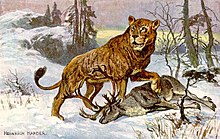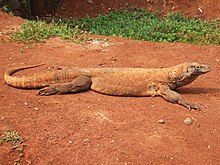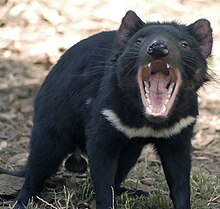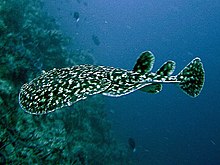List of apex predators: Difference between revisions
No edit summary |
|||
| Line 266: | Line 266: | ||
*[[Cougar]] - (''Puma concolor'') |
*[[Cougar]] - (''Puma concolor'') |
||
*[[Coyote]] - (''Canis latrans'') |
*[[Coyote]] - (''Canis latrans'') |
||
*[[crocodile]]- (''crocodilinae'') |
|||
*[[Crocodile monitor]] - (''Varanus salvadorii'') |
*[[Crocodile monitor]] - (''Varanus salvadorii'') |
||
*[[Culpeo]]* - (''Lycalopex culpaeus'') |
*[[Culpeo]]* - (''Lycalopex culpaeus'') |
||
Revision as of 23:54, 14 July 2016
This article needs additional citations for verification. (November 2007) |
This is a partial list of apex predators—those predators that are not preyed upon as healthy adults in the wild. Full scavengers (e.g. most vultures), although they may not be preyed on either, are not counted as apex predators unless they at least partially depend on capturing live prey. Many species listed here are only apex predators within certain environments, e.g. coyotes are only apex predators when larger predators such as the gray wolf or the brown bear are absent.
Extinct dinosaurs that are believed to be apex predators
Spanning several millennia, ages, epoch, and eras, these extinct carnivorous dinosaurs were likely apex predators based on their size and dietary needs. Some may have also been scavengers as well..



Other prehistoric apex predators
Terrestrial

Aerial

- Arambourgiania
- Argentavis
- Haast's eagle
- Harpactognathus
- Hatzegopteryx
- Meganeura
- Meganeuropsis
- Quetzalcoatlus
- Sericipterus
- Teratornis
Aquatic
Extant predators
These living carnivores or omnivores are apex predators.




Terrestrial
- The grey wolf as a species includes the dingo and all domestic dogs.

Aerial




Aquatic
Pagophilic
- Polar bear - (Ursus maritimus)
Notes: Animals with an asterisk (*) are only apex predators as introduced species. (**) Humans have debatable status[6]
References
- ^ Bargagli, Roberto (2004). Antarctic Ecosystems. Springer. pp. 282–287. ISBN 3-540-22091-7.
- ^ DeMartini, Edward E., Friedlander, Alan M., and Holzwarth, Stephani R. (2005). "Size at sex change in protogynous labroids, prey body size distributions, and apex predator densities at NW Hawaiian atolls". Marine ecology progress series 297: 259 -271. ISSN 0171-8630. Retrieved on 2006-12-21.
- ^ a b Lepak, Jesse M., Kraft, Clifford E., and Weidel, Brian C. (2006). "Rapid Food Web Recovery in Response to Removal of an Introduced Apex Predator". Canadian Journal of Fisheries and Aquatic Sciences 63(3): 569-575. ISSN 0706-652X. Retrieved on 2006-12-13.
- ^ Kuhn, Carey E., McDonald, Birgitte I., Shaffer, Scott A., Barnes, Julie, Crocker, Daniel E., Burns, Jennifer, and Costa, Daniel P. (2006). "Diving physiology and winter foraging behavior of a juvenile leopard seal (Hydrurga leptonyx)". Polar Biology 29(4): 303-307. ISSN 0722-4060. Retrieved on 2006-12-21.
- ^ Levner, Eugene; Linkov, Igor; Proth, Jean-Marie (2005). Strategic Management of Marine Ecosystems. Springer. p. 41. ISBN 1-4020-3158-0.
- ^ Roopnarine, PD (2014). "Humans are apex predators". Proc. Natl. Acad. Sci. U.S.A. 111: E796. doi:10.1073/pnas.1323645111. PMC 3948303. PMID 24497513.
